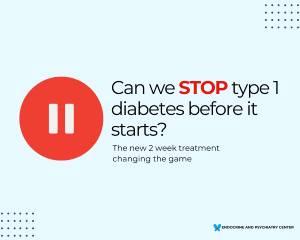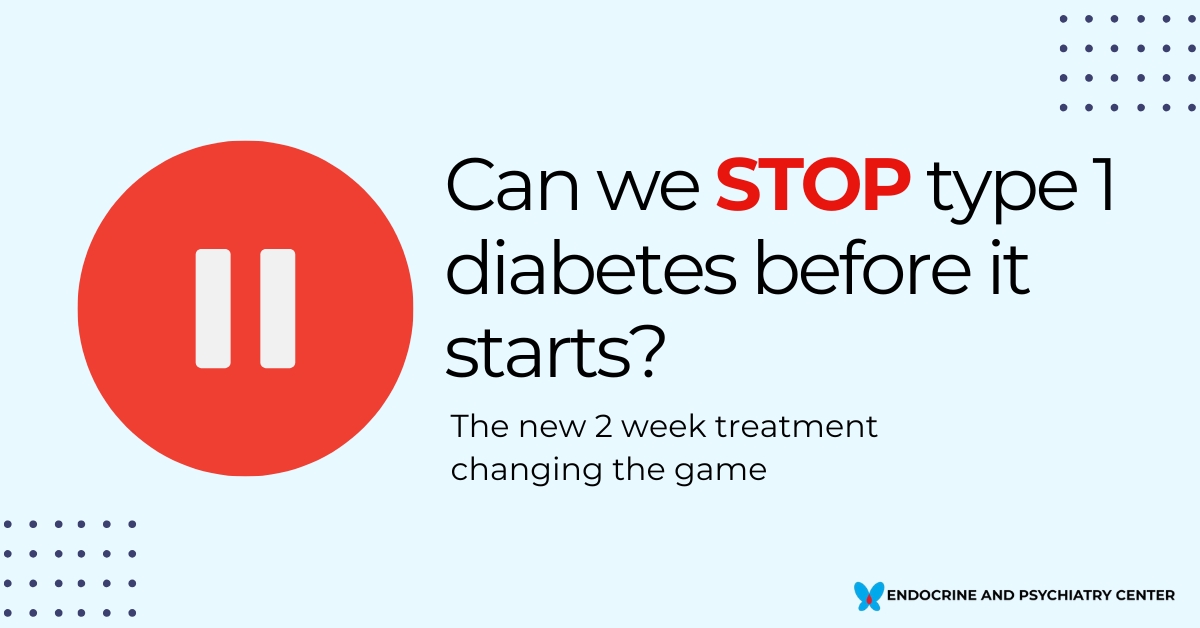- About Us
- Locations
- Meet the Team
-
Patient Resources
-
-
Patient Information
-
-
-
Services
-
-
All Services
-
Proudly Part of Privia Health

Time-Out for Type I diabetes? - How Teplizumab Slows Things Down

What Is Type 1 Diabetes?
Type 1 diabetes (T1D) is a condition where your immune system attacks the cells in your pancreas that make insulin. Insulin is the hormone that helps sugar (glucose) move from your blood into your body’s cells for energy.
Without enough insulin, sugar builds up in the blood. This can make people feel tired, thirsty, or even very sick. People with type 1 diabetes need to take insulin every day to stay healthy.
Type 1 diabetes usually shows up in children, teens, or young adults. But now, thanks to new science, we have a way to slow it down before it fully starts. That’s where Teplizumab comes in.
Meet Teplizumab: The Diabetes Delay Shot
Teplizumab (pronounced tep-LIZ-uh-mab) is a medicine that works with your immune system. It’s a type of treatment called a monoclonal antibody. That’s a fancy name for lab-made proteins that can block or change how the immune system acts.
Teplizumab doesn’t cure diabetes. But it can give people more time before they have to start insulin shots. Think of it as hitting the “pause” button on type 1 diabetes.
How Does It Work?
Let’s break it down in a simple way.
In type 1 diabetes, your immune system thinks the insulin-making cells (called beta cells) are bad guys. So it attacks them.
Teplizumab steps in like a referee. It calms down the part of the immune system that’s causing the trouble. This gives your beta cells a break and helps them survive longer. The result? Blood sugar levels stay more normal, and insulin isn’t needed as soon.
Who Can Use Teplizumab?
Teplizumab isn’t for everyone. It’s for people who are in the early stage of type 1 diabetes. This means:
- You have a family history of T1D
- You’ve tested positive for autoantibodies (signs that your immune system is starting to attack the pancreas)
- You still have normal or close-to-normal blood sugar levels
- You haven’t started insulin yet
If this sounds like someone in your family, talk to a doctor. A special blood test can tell if Teplizumab might be a good fit.
What Does the Treatment Look Like?
Teplizumab is given through a daily IV infusion over 14 days. You go to a clinic or hospital each day for a short visit.
It’s not a pill, and it’s not something you take at home. But the big idea is: 2 weeks of treatment can delay the need for insulin by up to 2 years or more. That’s a big deal for kids and families!
What Are the Benefits?
- More Time Without Insulin
Delaying diabetes means fewer shots, fewer blood sugar checks, and more freedom for a while. It can give children and families time to adjust and prepare. - Fewer Highs and Lows
Even after diabetes starts, people who took Teplizumab often have better blood sugar control and fewer dangerous highs or lows. - Hope for the Future
Teplizumab is the first drug to delay T1D. Scientists hope more treatments will follow. It opens the door for new ways to manage or even prevent type 1 diabetes someday.
What About Side Effects?
Like any medicine, Teplizumab can have side effects. Most are mild, like:
- Headache
- Rash
- Feeling tired
- Upset stomach
Some people may have more serious effects like:
- Lower white blood cell counts (these help fight infection)
- Reactions during the IV treatment
Doctors check for these problems during the 2-week treatment to keep patients safe.
How Much Does It Cost?
Right now, Teplizumab is a new treatment, and it can be expensive. But many insurance plans and patient support programs can help cover the cost.
It’s also important to know that not everyone needs this treatment. It’s only helpful if you're at high risk and in the early stages.
How Do I Know If My Child or Loved One Qualifies?,/h3>
Ask your doctor about a T1D antibody screening test. It’s a simple blood test that can show if someone is starting to develop type 1 diabetes.
This is especially helpful for:
- Kids who have a parent or sibling with type 1 diabetes
- Families who want to stay ahead of the disease
If the test shows high risk, your doctor may refer you to an endocrinologist to talk about Teplizumab and other next steps.
Is This a Cure?
Not yet. But it’s a big step in the right direction.
Teplizumab doesn’t stop T1D forever, but it can buy time. It gives kids a longer stretch of life without insulin, with better blood sugar control, and maybe even fewer long-term problems. Imagine a child having two more years of school, sports, or travel without needing daily insulin. That’s real progress.
What’s Next in Type 1 Diabetes Research?
Teplizumab is just the beginning. Scientists are working on:
- Better ways to predict who will get T1D
- Other medicines to calm the immune system
- A future where we might prevent type 1 diabetes entirely
Families who participate in research studies are helping make this future possible.
Key Takeaways
- Type 1 diabetes happens when the immune system attacks insulin-making cells.
- Teplizumab is a new medicine that delays the start of diabetes in high-risk people.
- It’s given through a 2-week IV treatment and can delay insulin use by up to 2 years.
- It’s for people who test positive for T1D autoantibodies but don’t yet need insulin.
- It’s not a cure—but it’s a powerful tool and a hopeful start.
Talk to Your Doctor
If type 1 diabetes runs in your family, don’t wait. Ask your doctor about T1D risk screening. It’s the first step to knowing your options and protecting your child’s future.
You can also visit TrialNet.org for free screening and more information.
Share This Post
now someone with type 1 diabetes in the family? Share this blog and spread the word about Teplizumab.
Let’s hit pause on T1D—together.